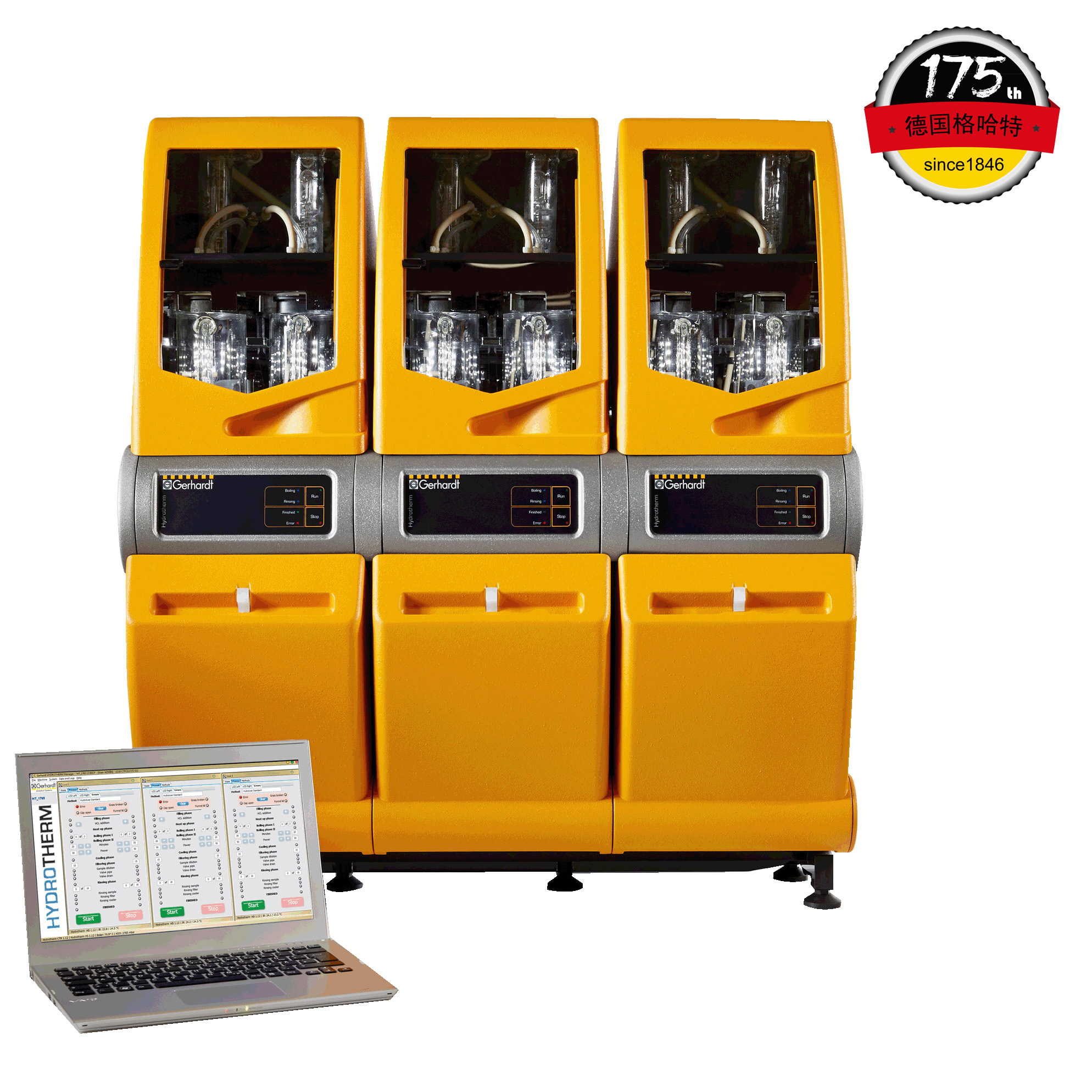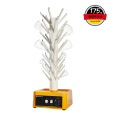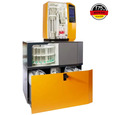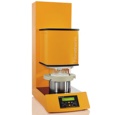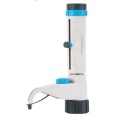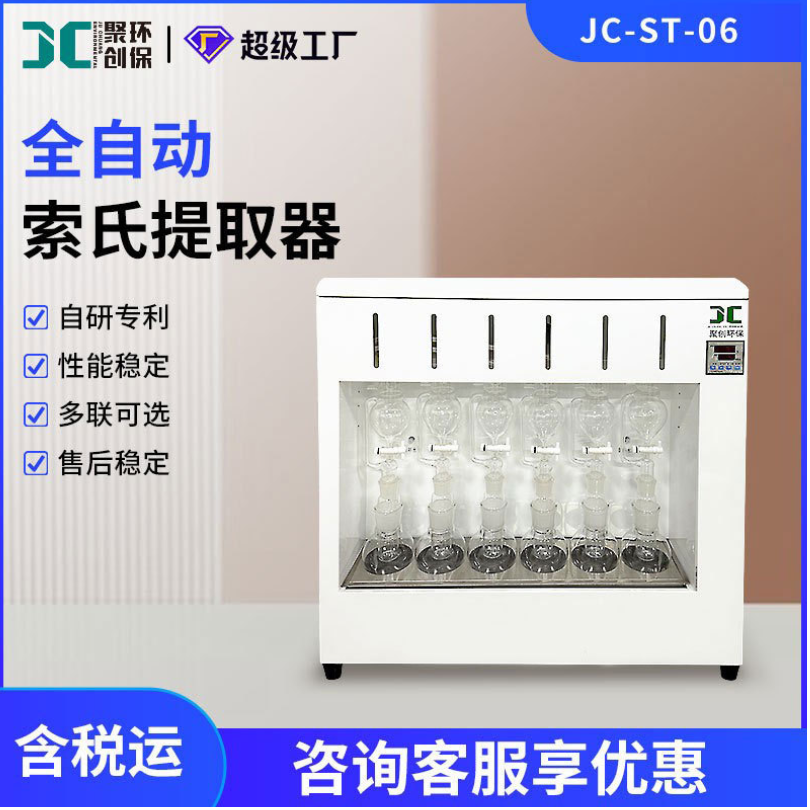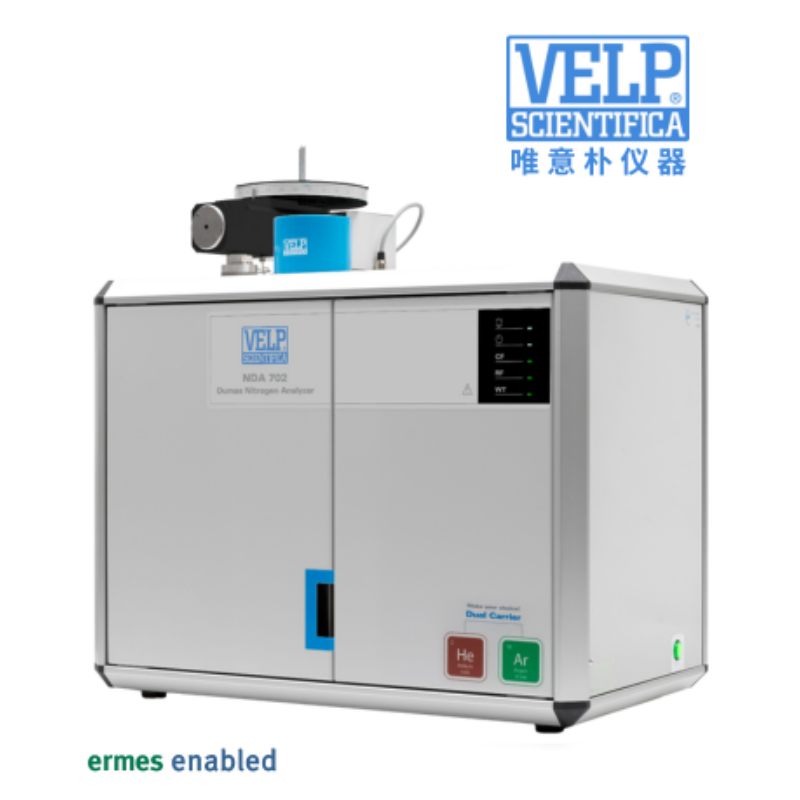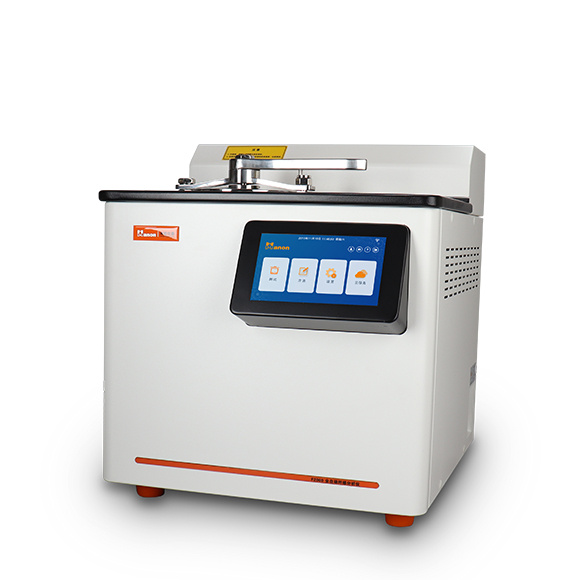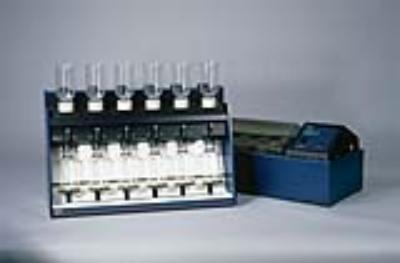断奶仔猪日粮中添加不同水平的烘培食品边角料粉对生长性能、福利和行为指标的影响Growth Performance, Welfare and Behavior Indicators in Post-Weaning Piglets Fed Diets Supplemented with Different Levels of Bakery Meal Derived from Food By-Products
方案详情

断奶仔猪日粮中添加不同水平的烘培食品边角料粉对生长性能、福利和行为指标的影响Growth Performance, Welfare and Behavior Indicators in Post-Weaning Piglets Fed Diets Supplemented with Different Levels of Bakery Meal Derived from Food By-Products2 of 12Sustainability 2023,15,12827 3 of 12Sustainability 2023,15,12827 断奶仔猪日粮中添加不同水平的烘培食品边角料粉对生长性能、福利和行为指标的影响 Article Growth Performance, Welfare and Behavior Indicators in Post-Weaning Piglets Fed Diets Supplemented with Different Levels of Bakery Meal Derived from Food By-Products Sofia-Afroditi Termatzidou 1*D, Anna Dedousi 1D, Maria-Zoi Kritsa 1D, George F. Baanniiaass 2D , Sotiris I. Patsios ²D and Evangelia N. Sossidou Veterinary Research Institute, Ellinikos Georgikos Organismos-DIMITRA, ELGO-DIMITRA Campus,570 01 Thermi, Greece; dedousi@vri.gr (A.D.); mzkritsa@gmail.com (M.-Z.K.); sossidou@vri.gr (E.N.S.) 2 Institute for Bio-Economy and Agri-Technology (IBO), Centre for Research and Technology-Hellas (CERTH),570 01 Thessaloniki, Greece; g.banias@certh.gr (G.F.B.); patsios@certh.gr (S.I.P.) Correspondence: termatzidou@heliadesvet.com Abstract: This study aimed to evaluate the effect of different levels (15% and 20% w.w-1) of bakery meal (BM) inclusion on growth performance, wel f are and behavior indicators in post-weaning piglets. Sixty post-weaning castrated male piglets were selected and divided in 3 feeding treatments: standard post-weaning diet with no BM added (CON), standard post-weaning diet with 15% w.w-1 BM added (BM 15) and standard post-weaning diet with 20% w.w-1 BM added (BM 20). Body weight (BW), average daily gain (ADG), feed intake (FI) and feed conversion ratio (FCR) were recorded individually on a weekly basis. Addi t ionally, welfare, quality behavior indicators, wounds and tai l -biting incidence were assessed. The supplementation with BM in piglets' diet had a significant i mpact on ADG and FCR during certain periods of t he t rial . BM 15 piglets showed higher ADG and lower FCR i n the last week of the experiment compared to CON piglets (1278.57 ±7.14 g vs. 905.00 ±47.86 gand 1.69±0.04 g vs. 2.35 ±0.08 g, respectively). Overal l , BM inclusion had no significant effect on performance, quality behavior characteristics and welfare (p>0.05). The inclusion of BM at either 15% or 20% w.w-1 illustrated no detrimental effects on the overall growth parameters, welfare and behavior indicators for post-weaned piglets. Citation: Termatzidou,S.-A.; Dedousi , A.;Kritsa, M.-Z.; Banias, G.F ; Patsios, S.I.; Sossidou, E .N Growth Performance, Welfare and Behavior Indicators in Post-Weaning Piglets Fed Diets Supplemented with Different Levels of Bakery Meal Derived from Food By-Produc t s. Sust a inability 2023,15,12827. https://doi.org/10.3390/ su151712827 Academic Editor: Dario Donno Received: 3 August 2023 Revised: 21 August 2023 Accepted: 22 August 2023 Published: 24 August 2023 Copyright: @ 2023 by the authors. L i censee MDPI, Basel, Switzerland. This article is an open access article distr i buted under the terms and conditions of the Creative Commons Attribution (CC BY ) l icense (https://creativecommons.org/licenses/by/4.0/) Keywords: bakery meal ; post-weaning piglets; performance; behavior; welfare 1. Introduction Feed cost constitutes up to 85% of the total production costs of a l ivestock farm [1]. More specifically, feed cost accounted for approximately 70% of the total pig cost in Spain over the period from 2010 to 2014, while the significant fluctuation of feed prices further increases economic risk [2]. The pork industry, especially in EU countries, is facing lower profit margins per animal, leading to the need for new nutritional strategies to increase its competitiveness and the farmers' rev 70e n n 1u 1e [2,3]. Concurrently, food wastage within the food production and consumption value chain remains a major global problem [4]; it is estimated that approximately one third of food produced for human consumption is either lost or wasted, amounting to a financial loss of about US$1 trillion per year [5]. In order to reduce food losses and minimize animal production costs, researchers have been focused on the evaluation of new sources of feed ingredients, such as agro-industrial by-products, former food products (FFPs), etc., as alternatives to conventional feed ingredients. A key advantage of these alternative feed ingredients i s t he reduced dependence i n animal produc t ion on cereals, which are also consumed by humans [6]. Among the alternative feed i ngredients that can be used in animal ration formulations, bakery FFPs and by-products can be an excellent choice due to their energy content; high palatability; low levels of anti-nutritional agents, such as fiber, tannins, glucosinolates and heat-labile trypsin inhibitors; and their constant availability on the market [7,8]. Dried bakery meal (BM) i s a mixture of breads, cookies, cakes, crackers, doughs, chips, pasta, snacks, nuts, cereals, f lour, baked goods and related food by-products that have been separated from non-edible materials, mixed, ground and heat-treated [9,10]. These FFPs are economical feed ingredients consisting of processed and ready-to-eat bakery products that are no longer suitable for human consumption due to manufacturing or packaging defects [10]. The use of FFPs in animal feed production is regulated by feed legislation, in which there is a clear distinction between former food and food waste, that enables their marketing as a safe feedstuff that cannot be degraded to food waste [11]. Feeding FFPs to livestock enables losses of high-quality food materials to be reduced, returned to the supply chain and re-used [12,13]. Moreover, this practice aligns with the concept and principles of circular economy, which i mplies the reduction of food waste generated in the food systems, re-use of food by-products, nutrient recycling and a shift in nutrition towards more diverse and more efficient food patterns [14]. In the European Union, the use of FFPs has already been implemented in animal feed production. How-ever, it remains limited (3.5 mi l lion tons/year) [15] compared to the total discarded food (88 mi l lion tons/year) [16]. The inclusion of BM derived from food by-products as a feed ingredient in animal diets has been mainly investigated as an alternative poultry and swine nutritional management practice [17-20]. I t can be assumed that 1 ton of BM is equivalent to 850 kg of corn, 90 kg of soybean meal (44% w.w-1 protein content) and 60 kg of fat/oil [9]. The nutritional evaluation of six different mixtures of bakery by-products used in pig rations showed that their nutritional composition is comparable to that of cereals [15]. BM has protein and amino acid contents similar to those of corn (10.8% crude protein, 0.27% lysine and 0.10%tryptophan) but higher fat content (11%). I t is also rich in starch, as wheat f lour i s the main ingredient in most bakery products. The starch contained in BM is thermally processed, increasing its digestibility and nutritional value, rendering BM ideal for feeding growing pigs [8]. However, there i s a scarcity of research evidence regarding the optimal i nclusion rate of BM in piglets' post-weaning diets, as well as its impact on growth performance and welfare. In fact, despite the obvious advantages concerning feed sustainability due to the more efficient use of natural resources (i.e., land, water, energy etc.), i t is reported that the main limiting factor of the use of FFPs is the lack of information on their nutritional properties and their safe use in animal diets [13]. Therefore, the purpose of this study is to systematically assess the effect of different levels (15% and 20% w.w-1) of BM inclusion on the growth performance wel f are and behavior i ndicators in post-weaning piglets. The experimental trial was conducted in a commercial pig farm, employing different batches of BM produced from various locally collected bakery FFPs, to closely simulate the constraints and conditions of real, commercial-scale use of BM. 2. Materials and Methods 2.1. Bakery Meal Production 曲奇 酥皮糕点面包 羊角面包 BM was produced in three different production batches. The bakery FFPs for BM production consisted of pasta, cookies, cereals, chocolates, pastry, breads, croissants, etc. that were still edible but not meant for human consumption. The amount of each bakery FFP in the production batch changed depending on the availability of the by-products; chocolates were always less than 10% w.w-1 in all production batches. The bakery FFPs were collected and gathered at a BM producing plant in northern Greece, unpacked, ground and thermally treated. The thermal treatment comprised a t least 20 min of retention time, at 133 °C and 3 bar. During the therma l treatment, the BM weight was reduced by approx. 60% w.w- due to moisture removal . The produced BM was a crumbling/coarse brown powder, which was put into 20-kg bags and stored in a dry and cool place under ambient conditions. Two samples from each batch of BM production were collected for physicochemica l and microbiological analysis. 2.2. Bakery Meal Characterization The physicochemical analysis of the basic nutrients was performed according to Euro-pean Commission (EC) Regulation No. 152/2009 [21] for the following parameters: dry matter,,crude protein, ash,, crude fats and crude fiber. The carbohydrate content and the gross energy were calculated based on the proximate analysis. The sugar content was measured via an enzymatic method used for mono- and di-saccharides analysis in plant and food products (Megazyme K-SUFRG 04/18 assay kit, Megazyme, Wiklow, Irland). The starch content was also determined enzymatically, employing the Megazyme K _TSA _100A assay kit. The concentrations of mono-, poly-unsaturated and saturated fatty acids were determined according to the EC Regulation No. 2568/91 [22]. The extracted fatty acids, via the Soxhlet extraction method (Soxtherm SOX412-MACRO, Gerhardt GmbH & Co. KG, Konigswinter, Germany), were analyzed via GC-FID (GC-2010 Plus, Shimadzu Co., Japan) employing a Supelco SP2560 column, after alkaline t ransesterification according to Dedousi et al. [23]. The peroxide value (PV) of l ipids was determined according to the EU 2568/91 method [22] based on the free iodine titration after oxidation of a potas-sium iodide solution. The concentrations of aflatoxins B1, B2, G1 and G2 and mycotoxins Deoxynivalenol (DON) and Zearalenone (ZON) were analyzed according to available pro-tocols [24,25]. The BM was also microbiologically characterized via real-time PCR methods 127for the following parameters: Enterobacteriaceae [26], Salmonella spp. [27], Campylobacter spp. [28] and African swine fever virus (ASFV). More specifically, the presence of ASFV was determined by using the commercial real-time PCR assay ID Gene African Swine fever Du-plex (IDvet, Innovation Diagnostics Inc., Grabels, France). The kit includes an endogenous positive control that is used for ensuring the correct DNA amplification. Additionally, the method was validated for the detection of ASFV in the BM by spiking the ASFV positive control in the crude sample. The results concerning the characterization of the BM are summarized in Table 1. Table 1. Nutrient analysis, amino acid composition profile, aflatoxin and mycotoxin concentrations and microbiological characterization of the BM used in this study. Data are presented as mean values ± SD; the data comprise t hree production batches and six samples in total . Parameter Amino Acids (g/kg) Moisture and volatiles (g/100 g) 9.48±3.79 Alanine 11.5±8.4 Ash(g/100g) 7.54±2.20 Arginine 9.4±5.7 Fat (g/100 g) 21.13±4.37 Aspartic acid 18.0±7.5 Proteins (g/100 g) 25.91±4.96 Glutaminic acid 31.0±19.1 Crude fibers %(g/100g) 1.35±1.33 Glycine 25.2±11.4 Carbohydrates (g/100 g) 34.47±9.20 Histidine 9.6±9.4 Sugars (g/100 g) 5.79±6.33 Isoleucine 10.3±3.5 Starch (g/100 g) 19.33±2.95 Leucine 13.8±8.4 Energy (kcal/100 g) 431.7±35.7 Lysine 15.5±8.0 Fatty Acid (FA) Composition Methiononine 11.2±9.9 Monounsaturated FA-MUFA (%w.w-1) 35.6±7.5 Phenyalanine 12.8±3.8 Polyunsaturated FA-PUFA (% w.w-) 14.2±3.8 Proline 23.5±24.7 Saturated FA-SFA (% w.w-1) 50.2±13.7 Serine 11.9±4.9 Iodine value (meq O2/kg) <0.5*-2.0 Threonine 10.1±4.5 Tryptophane 1.3±0.7 Tyrosine 8.3±3.7 Valine 12.3±4.9 Microbiological Aflatoxins and Mycotoxins (ug/kg) characterization (cfu/g) Aflatoxin B1 <0.5*-4.5 Enterobacteriaceae <9.0*-270 Aflatoxin B2 <0.5*-1.0 Campylobacter spp. ND Aflatoxin G1 <0.5*-1.5 Salmonella spp. ND Aflatoxin G1 <0.5* ASFV 3 ND SUM of aflatoxins <2.0*-7.0 ZONI <2.0*-31 DON 2 <40*-244 * This value i s t he detection limit of the assay. ND: not de t ec t ed; Zearalenone;2 Deoxynivalenol;3 Af r ican swine fever Virus. 2.3. Animals, Diets and Experimental Design The experiment was conducted at the facilities of a commercial pig farm located in Nea Tenedos, Chalkidiki, Greece (40°21'48.3"N, 23°15'49.7" E). Sixty post-weaning castrated male piglets with intact tails (Pietrain breed, 28 days old, with mean body weight 8.57 ±0.20 kg) were selected for the study. The piglets were randomly allocated into six consecutive pens (10 piglets.pen-1, space allowance 0.15 m²/piglet). Each pen had a perforated plastic floor, was equipped with a feeder and nipple drinkers and was enriched with iron chains serving as a toy for the piglets. The stocking density in each pen met the requirements of EU directives [29]. All pens were at the same faci l ity in order to obtain the same environmental conditions for all groups. Piglets had ad libitum access to feed and water. During the experimental period, the temperature and relative humidity were automatically controlled and followed recommendations for t he post-weaning production phase [30]. After a seven-day adaptation period, the piglets were divided into 3 feeding treat-ment groups: standard post-weaning diet with no BM added (CON), standard post-weaning diet with 15% w.w-1 BM added (BM 15) and standard post-weaning diet with 20% w.w-1 BM added (BM 20), with 20 piglets.group-1, 2 replicates-pens.group-1and 10 piglets.replicate-pen -1. A t wo-phase f eeding program was applied for each dietary treatment, consisting of a growing 1 diet, fed from 28 to 60 days of age, and a growing 2 diet, fed from 60 to 84 days of age. In total, 6 diets were formulated (Table 2). In the BM diets, conventiona l i ngredients, mainly corn and soya, were replaced with BM to formulate al l rations on an isonitrogenous and isocaloric basis. The rations were offered as mash and met the National Research Council (NRC) energy requirements. The duration of the trial was 56 days. Table 2. Physical and chemical composition of experimenta l diets (dry matter basis). Growing 1 (Days 28-60) Growing 2 (Days 60-84) Items CON BM 15 BM 20 CON BM 15 BM 20 Ingredient composition Maize meal 25.00 25.00 20.00 25.00 25.00 22.00 Corn 10.00 5.00 8.00 15.30 8.30 8.30 Wheat pollard 30.00 25.00 19.00 32.00 29.00 27.00 Bakery meal 0.00 15.00 20.00 0.00 15.00 20.00 Wheat 5.00 5.00 5.00 7.00 7.00 8.00 Soya 47 14.60 10.00 9.00 15.00 10.00 9.00 Vitamin and mineral premix 6.00 6.00 6.00 2.50 2.50 2.50 Soybean oil 2.00 1.60 0.60 0.00 0.00 0.00 Whey 5.00 5.00 10.00 0.00 0.00 0.00 NatuPro 2.00 2.00 2.00 2.00 2.00 2.00 Zinc Oxide 0.30 0.30 0.30 0.30 0.30 0.30 Mycotoxin binders 0.10 0.10 0.10 0.10 0.10 0.10 Marble powder 0.80 0.80 0.80 100.00 100.00 100.00 100.00 100.00 100.00 Chemical composition Dry matter (%) 87.5 88.7 89.2 88.4 89.8 91.1 Crude protein (%) 15.26 14.42 14.43 14.25 13.62 13.27 Crude fiber (%) 3.59 3.28 3.23 3.21 2.95 2.71 Ether extract (%) 3.01 6.36 7.43 4.74 7.65 8.18 Crude ash (%) 3.24 3.35 3.46 2.69 2.84 3.32 Gross energy (Mj/kg) 15.57 16.04 16.22 13.98 14.59 14.14 Metabolizable energy (Mj/kg) 12.71 13.17 13.28 11.46 12.04 11.67 2.4. Production Traits Body weight (BW) was measured individually at the beginning of the t rial (28 day of age) and then weekly, on a weighing platform (accuracy 0.5 kg) until t he end of the experiment (84 days of age). Feed intake (FI) and mean average daily gain (ADG) per pig were calculated at weekly intervals as well as for the whole experimental period (28-84 days of age). Similarly, based on FI and ADG, the feed conversion ratio (FCR) per pig was determined at weekly intervals and t hroughout the study. Orts were collected and weighed once a week in order to calculate FI . Mortality rate was recorded daily. Body condition score and health status were also evaluated on a weekly basis. 2.5. Welfare Assessment Welfare and quality behavior indicators were assessed at the beginning of each eval-uation day (10:00 a.m.) by the same evaluator. Welfare assessment was performed on a weekly basis according to t he suggested methodology of the Welfare Quality @ Assessment protocol for pigs [31]. The quality behavior characteristics (active, fearful, distressed, calm, bored, playful, sociable, feeding) were interpreted by individual visual observations, with a duration of 2 min in each pen. The number of piglets observed in each behavior category was noted, divided by the total number of pigs in each group and multiplied by 100. Moreover, piglets were i ndividually scored for wounds on the body and incidences of tail-biting during each 10 min observation period per pen. Wounds were inspected on both sides of the body. Piglets were assigned a score of 0 when there was no evidence of wounds, a score of 1 if all regions of the body had 5 to 10 lesions, and a score of 2 when >10 lesions were observed on a minimum of 2 zones of the body or if any zone had >15 lesions. Tail-bi t ing i nc i dence was evaluated using a 2-point scale; a score of 0 referred to no evidence of tail-biting, while a score of 2 was indicative of bleeding tail and/or swollen infected t ail lesion and/or part of tail t issue missing and presence of crust [32]. 2.6. Statistical Analysis The data were tested for normality with the Shapiro-Wilk test before statistical analysis. The piglet was considered the experimental unit. The significance of the differences between welfare and quality behavior indicators among the groups was assessed via Chi-square test. One-way analysis of variance (ANOVA) was used to compare means of the examined parameters between different feeding treatments. Levene’s test was performed to check homogeneity of variances. Post-hoc analysis was undertaken using the LSD test. Significance l evel was set at p < 0.05. Data were analyzed using IBM SPSS v.22.0 (Armonk, NY, USA: IBM Corp.). 3. Results Al l animals remained clinically healthy throughout the study and no morbidity issues were reported, with the exception of two piglets that died during the study, one from BM 15 group at the 4th week and one from CON group in the 6th week. Post mortem findings were indicative of enzootic pneumonia. The available data of those animals were excluded from the statistical analysis. The BM supplementation in the piglets’ diet had a significant impact on ADG and FCR during certain periods of the trial. Specifically, BM i nclusion had a significant effect on ADG from 57 to 63 and 78 to 84 days of age (p=0.035 and p=0.004, respectively). Moreover, the experimental diets had a significant i mpact on FCR from 28 to 35 (p=0.025), from 57 to 63 (p=0.024) and from 78 to 84 (p=0.003) days of age, respectively. The effect of different leve l s of BM inclusion on growth and performance characteristics among the three experimental groups are presented in Table 3. At 35 and 42 days of age, BM-fed piglets presented higher BW compared to the CON group. However, significant differences were observed only between the BM 15 and CON groups (p = 0.029 and 0.046, respectively). Similarly, ADG was significantly higher in the BM 15 group from 28 to 35(p=0.039) and 78 to 84 (p=0.003) days of age compared to the CON group. A significant difference was reported between those groups during t he fifth week of the t rial , with ADG being lower in the BM 15 group (p=0.023). Additionally, higher ADG was observed in the BM 20 group from 36 to 42 days of age (p=0.033). Moreover, the BM 15 piglets had a higher FI from 36 to 42 and 50 to 56 days of life compared to the CON (p=0.008) and BM 20 (p=0.004) ones, respectively. From 57 to 63 days, FI was lower in the BM 20 group (p=0.013). The best FCR was reported in the BM 15 group during the first and the last week of the experimental period (p=0.013 and 0.003, respectively). From 36 to 42 days, FCR was lower in the BM 20 group compared to the CON group (p=0.022). The BM 15piglets had a higher FCR from 57 to 63 days of life compared to the CON and BM 20 groups (p=0.022 and 0.012, respectively). Overall, none of the evaluated performance parameters differed significantly among the t hree groups (p>0.05). T able 3. Growth and performance characteristics of piglets fed the control and diets containing different levels of BM. Data are presented as mean ± SE values. Variables CON BM 15 BM 20 BW (kg) Day 28 8.66±0.22 8.74±0.12 8.32±0.20 Day 35 10.69±0.0654 11.32±0.15 10.81±0.12ab Day 42 12.26±0.12a 13.42±0.18 13.21±0.38ab Day 49 15.55±0.50 15.55±0.50 15.00±1.00 Day 56 19.50±0.50 21.06±0.06 20.50±0.50 Day 63 24.50±0.50 25.28±0.28 25.50±0.50 Day 70 31.06±0.06 31.06±0.06 31.00±0.01 Day 77 37.39±0.39 36.89±0.89 35.55±0.50 Day 84 43.72±0.72 45.84±0.84 44.50±0.50 Overall (28-84d) 35.06±0.77 37.10±0.83 36.19±0.51 ADG (g) 28-35d 289.64±1.78a 368.57±21.43D 355.71±17.14 ab 36-42d 225.00±7.86a 300.71±5.00ab 342.86±37.15 43-49 d 462.86±88.57 297.15±45.72 256.43±89.29 50-56 d 571.43±142.86 793.58±79.29 785.72±71.43 57-63d 714.29±0.01a 602.86±31.43b 714.29±0.01ab 64-70d 936.43±79.29 825.72±31.43 785.72±71.43 71-77 d 904.29±47.15 832.86±188.57 642.86±71.43 78-84d 905.00 ±47.86a 1278.57±7.14D 1285.71±0.01D Overall (28-84d) 626.12±13.80 662.50±14.82 646.16±9.02 FI(Kg) 28-35d 3.33±0.08 3.38±0.12 3.44±0.01 36-42 d 4.14±0.07a 4.67±0.08D 4.40±0.01ab 43-49d 6.40±0.02 6.36±0.06 6.49±0.08 50-56d 7.32±0.04ab 7.82±0.23a 6.78±0.28D 57-63 d 8.96±0.04b 8.98±0.07b 8.55±0.05a 64-70d 9.28±0.28 9.06±0.06 8.88±0.08 71-77d 14.78±0.28 14.60±0.16 14.40±0.15 78-84d 14.89±0.29 15.09±0.24 14.50±0.10 Overall (28-84 d) 68.59±0.29 69.95±0.29 67.40±0.10 FCR 28-35d 1.65±0.05a 1.31±0.03b 1.38±0.06D 36-42d 2.63±0.05a 2.22±0.08ab 1.85±0.20D 43-49 d 2.05±0.39 3.13±0.46 4.10±1.39 50-56 d 1.95±0.48 1.42±0.10 1.24±0.06 64-70d 1.79±0.01b 2.14±0.01a 1.71±0.01D 1.42±0.08 1.57±0.07 1.63±0.16 71-77 d 2.34±0.08 2.56±0.39 3.25±0.40 78-84d 2.35±0.08a 1.69±0.04D 2.56±0.39D Overall (28-84d) 1.96±0.04 1.89±0.04 1.86±0.03 The percentages of piglets observed in the 3 dietary treatments (CON, BM 15, BM 20) scoring for quality behavior characteristics (active, fearful, distressed, calm, bored, playful, sociable, feeding) are presented in Table 4. On the majority of the evaluation days, the addition of BM to the diets had no significant effect (p >0.05) on quality behavior characteristics. At day 63, BM 15 piglets were evaluated as more active compared to CON ones (p=0.038). Moreover, at day 70, BM 20 piglets were calmer compared to BM 15 and CON ones (p=0.008and 0.003, respectively). Table 4. Percentage (%) of piglets observed in the 3 dietary treatments (CON, BM 15, BM 20) scoring for quality behavior characteristics (active, fearful , distressed, calm, bored, playful, sociable, feeding) at each evaluation dav. Qual i ty Behavior Characteristics Active Fearful Distressed Calm Bored Playful Sociable Feeding CON 75.00 0 5 0 0 0 0 20.00 Day 35 BM 15 80.00 0 0 0 0 0 0 20.00 BM 20 75.00 0 0 0 0 0 0 25.00 CON 65.00 0 0 0 0 0 0 35.00 Day 42 BM 15 70.00 0 0 0 0 0 0 30.00 BM 20 75.00 0 0 0 0 0 0 25.00 CON 65.00 0 0 0 0 0 0 35.00 Day 49 BM 15 60.00 0 0 0 0 0 0 40.00 BM 20 75.00 0 0 0 0 0 0 25.00 CON 50.00 0 0 0 0 0 0 50.00 Day 56 BM 15 52.63 0 0 0 0 21.05 0 26.32 BM 20 15.00 0 0 15.00 5.00 25.00 0 40.00 CON 30.00a 0 0 5.00 5.00 5.00 5.00 50.00 Day 63 BM 15 63.16b 0 0 0 0 5.26 0 31.58 BM 20 60.00 ab 0 0 0 0 15.00 0 25.00 CON 26.32 0 0 31.58b 0 10.53 0 31.57 Day 70 BM 15 42.10 0 0 26.32b 0 0 0 31.58 BM 20 15.00 0 0 85.00a 0 0 0 0 Day 77 CON 42.10 0 0 10.53 0 10.53 0 36.84 BM 15 36.84 0 0 10.53 0 0 0 52.63 BM 20 40.00 0 0 20.00 0 10.00 0 30.00 a,b Means within a column at a particular age for each type of behavior with different superscripts differ significantly (p<0.05). Data regarding the impact of BM inclusion on body wounds and tail-biting incidence are presented in Table 5. The percentage of piglets assigned a body wound score of 0, 1 or 2did not differ significantly among different experimental groups (p>0.005). However, a significantly higher percentage of piglets with bleeding tails and/or swollen infected tail lesions and/or missing parts of tail tissue and presence of crus t was reported in the BM 15 group in the 3rd week and peaked in t he 5th week of the trial (p<0.005). Table 5. Percentage (%) of piglets observed i n the 3 dietary treatments (CON, BM 15, BM 20) scoring for welfare indicators (body wounds, tail-biting incidence) on each evaluation day. Welfare Indicators Body Wounds Tail Biting Incidence 2 Score Score 0 1 2 0 2 Day 35 CON 95.00 5.00 0 100 0 BM 15 95.00 0 0 100 0 BM 20 95.00 5.00 0 100 0 Day 42 CON 95.00 5.00 0 100 0 BM 15 90.00 10.00 0 100 0 BM 20 85.00 15.00 0 100 0 Day 49 CON 90.00 10.00 0 100b 0b BM 15 95.00 5.00 0 80.00a 20.00a BM 20 80.00 20.00 0 100b 0b Day 56 CON 85.00 10.00 5.00 100b 0b BM 15 73.68 15.79 10.53 68.42a 31.58a BM 20 70.00 25.00 5.00 100b 0b Day 63 CON 80.00 15.00 5.00 100b 0b BM 15 63.15 26.32 10.53 68.42a 31.58a BM 20 70.00 25.00 5.00 100b 0b Day 70 CON 63.16 21.05 15.79 100 0 BM 15 42.11 21.05 36.84 89.48 10.52 BM 20 55.00 35.00 10.00 100 0 CON 42.10 31.58 26.32 100 0 Day 77 BM 15 26.31 26.32 47.37 89.48 10.52 BM 20 55.00 35.00 10.00 100 0 a,b Means within a column at a particular age (Day 35-Day 77) for each score category 0-2 with different superscripts differ significantly (p<0.05). I Body Wounds: Score 0: no evidence of wounds; Score=1: all regions of the body had 5 to 10 lesions; Score=2: >10 lesions were observed on a minimum of 2 zones of the body or any zone had >15 l esions. 2 T ai l biting: Score 0: no evidence of tai l biting; Score =2: bleeding tail and/or swollen infected t aillesion, and/or part of tai l tissue missing and presence of crust. 4. Discussion As asserted i n the i ntroduction, there is a notable scarcity of research data regarding the inclusion of BM in the rations of post-weaned piglets. Digestibility and the effect of bakery FFPs on growth performance have been mainly determined in growing-finishing pigs [33-36], reporting conflicting results regarding feed efficacy. However, in most cases, no depression in growth rate of the animals was observed. Piglets are exposed to a variety of stressors during weaning, such as separation from the dam, changes in housing environment, mixing with unfamiliar litters and transition from milk to a solid diet [37]. The addition of BM to post-weaning diets could be a challenge for their immature digestive systems. Nevertheless, BM can replace a significant percentage of cereal grains in pig diets due to a chemical composition similar to that of wheat and barley [38]. In our study, the chemical analysis of experimenta l BM diets revealed that crude protein and metabolizable energy content were similar to conventional diets and comparable with other studies [1,39]. The main concern in using BM in pig rations i s the variability in chemical and nutritional composition of each batch, according to the available raw materials. However, i t has been demonstrated that the nutrient profile of BM is rather consistent regardless of the origin of production [40] The inclusion of BM in post-weaning diets did not compromise the overall growth performance of the piglets in our trial. At weekly intervals, significant differences in BW, ADG and FCR were recorded among experimental groups. Although FI was lower in the CON group during the first weeks of the trial, overall performance and FCR were not affected as the experiment progressed. Overal l , although BW and ADG values were numerically higher and FCR was better in the BM 15 and BM 20 groups, the differences were not statistically significant. Those results are in accordance with what Tiwari et al. [41] observed when they replaced maize in basal diets with different levels of bakery FFPs. The inclusion of 20% w.w -1 bakery FFPs resulted in t he highest total weight gain and ADG compared to 0%, 10% or 30% w.w-1 levels, although the overall differences in growth performance at the end of the trial were not statistically significant. Similarly, Tretola et al. [42] did not report any depression in growth rate by using bakery, pasta and confectionary by-products at levels up to 30% w.w- in post-weaning diets. No detrimental effec t s on growth and FCR were observed, even with high substitution of corn (50%) with bakery FFPs [43]. On the contrary, Luciano et al. [44] recorded a decrease in overall and ADG of pigs from day 15 to 35 as the concentration of BM increased in the diets, indicating that a total replacement of maize may not be beneficial during this crucial period. Narayanan et al. [45] performed a trial in 7-day-old piglets, in which the control group were fed swine starter feed and the experimental group were fed crumbled biscuits, ad libitum in both cases. The final body weights at the end of 8th week were 14.10 ±2.27kg and 10.97 ±1.6 kg for the control and the experimental group, respectively. Thus, protein supplementation is necessary to obtain optimal growth when BM is provided as the only feed source. The inclusion of BM has been more extensively studied compared to t rials conducted in post-weaning piglets. In many of these studies, no significant differences in growth performance parameters were observed between control and experimental groups. These investigations have yielded valuable data on the optimal percentage of BM inclusion, providing insights into its potential as a sustainable dietary component. Indicatively, Manu et al . [46] concluded t hat discarded biscuits can make up to 30% of the ration of growing pigs, replacing corn at about 60% adversely affecting carcass yield and quality. Similarly, Barman et al. [43] and Tiwari and Dhakal [8] reported that bakery waste has no detrimental effect on growth characteristics when it replaces corn at 50% or 75%,re-spectively. These findings indicate the feasibility of using BM as a partial substitute for conventional ingredients in growing pig diets without compromising growth performance. However, it i s impor t ant to consider the potential impact of higher levels of BM inclusion. Ojediran et al. [47] reported t hat replacing corn with biscui t dough at a level of 37.5% had a significant effect on the FCR of growing pigs. Similarly, Kumar et al. [36] indicated that the percentage of bread waste inclusion in diets should not exceed the level of 50% in order to el i minate the possibil i ties of FI decrease and gastrointestina l disorders. In l ight of the available literature and t he goal of maintaining optimal animal performance, we chose to use the l owest inc l usion rates of BM in our trial. This cautious approach aimed to minimize the risk of potential negative effects on the post-weaning piglets' growth and well-being. To further optimize the use of BM in post-weaning diets, additional research is warranted. Welfare and performance of l ivestock are strongly correlated with gut health [48]. Tretola et al. [42] reported that the composition of gut microbiota changed after the inclusion of FFPs in the diets of post-weaning piglets. However, they did not measure the possible ef f ect of this addition on welfare indicators. To our knowledge, the present study is the f irst one reporting the possible impact of BM incorporation in post-weaning diets on welfare and quality behavior indicators. No evidence of severe welfare i ssues was reported during the trial, with the exception of the tail-biting incidence in BM 15 group that was first reported at day 49 and lasted approximately three weeks. There are a variety of risk factors that can trigger this abnormal behavior, such as health issues, stress, feed, barn climate, stocking intensity and lack of enrichment materials [49]. In our case, i t was a challenge to identify the cause of this outbreak, as preventative measures were applied i n all groups. This behavior affected performance characteristics of the group, mainly FCR and ADG parameters, during the fifth week of the experiment. After the identification and separation of the biter, the remaining piglets recovered quickly, and their weight gain was compensated for during the remaining weeks of the trial. 5. Conclusions The results obtained in the present study provide valuable insights into t he potential utilization of BM in the formulation of post-weaning piglet diets . The inclusion of BM at either 15% or 20% w.w-1 caused no detrimental effects on the overall growth parameters of the piglets. This f inding is promising as it suggests that BM can be a sustainable and cost-effective alternative in piglet nutrition without compromising their growth perfor-mance. Moreover, the use of BM did not negatively impact the welfare and quality behavior indicators for post-weaned piglets. Despite the reported variability i n specific physico-chemical characteristics of the different BM batches, i t i s noteworthy that this variability did n Ce ot seem to affect the reported results, and the use of the BM was successfully employed. This resilience i n the face of batch variation highlights the feasibility and adaptability of incorporating BM into piglet diets, making it a reliable option for sustainable and circular food practices. While this study sheds light on the growth and welfare aspects of using BM in post-weaning piglet diets, there are still several unexplored areas that warrant further investigation. Future research should delve i nto assessing the impact of BM inclusion on other critical parameters, such as the gut microbiota composition, the carcass quality through meat analysis and tas t e panel assessment and the overall pig farm environmental and economic sustainability comprising a cost-benefit analysis. Understanding the effects of BM on these aspects will provide a more comprehensive evaluation of i ts potential benefits and implications for the pig farming industry. Author Contributions: Conceptualizat i on , S.-A.T . and E .N.S.; methodology, A.D. and S.I.P.; sof t ware, S.-A.T . and A.D.; validation, A.D., G.F.B. and E.N.S.; formal analysis,S.-A.T.; investigation, A.D. and M.-Z.K.; resources,E.N.S.; data curation, S.-A.T. and E.N.S.; writing-original draft preparation, S.-A.T.; wri t ing一review and editing, A.D., M.-Z.K., G.F.B., S.I .P. and E.N.S.; visualization, G.F.B. and S.I .P.; supervision, E.N.S.; project administration, E.N.S.; funding acquisition, S.I.P. and E.N.S. All authors have read and agreed to the published version of the manuscript. Funding: This research has been co-f inanced by the European Regional Development Fund of t he European Union and Greek national funds through the Operational Program Competitiveness, Entrepreneurship and Innovation, under the call RESEARCH-CREATE-INNOVATE (project code:T2EDK-04537). Institutional Review Board Statement: The study was conducted in accordance with the Declaration of Helsinki and approved by t he Committee for Research Ethics of Hellenic Agricultural Organization DIMITRA (Protocol Number 14948/6-03-2023). Data Availability Statement: The data presented in this study are available on request from the corresponding author. The data are not publicly available due to privacy. Acknowledgments: We sincerely thank the pig f arm CHALKIDIKI S.A, which provided the experi -mental animals and facili t ies for this study, as well as Nektaria Papadaki for providing primary data. Conflicts of Interest: The authors declare no conflict of interest . References 1. Luciano, A.; Tretola, M.; Ottoboni, M.; Baldi , A.; Cattaneo, D.; Pinotti, L. Potentials and Challenges of Former Food Products (Food Leftover) as Alternative Feed Ingredients. Animals 2020, 10, 125.[CrossRef ] [PubMed ] 2. Rocadembosch, J.; Amador, J .; Bernaus, J.; Font, J.; Fraile, L.J. Production parameters and pig production cost: Temporal evolution 2010-2014. Porc . Health Manag. 2016,2,11. [CrossRef ][PubMed ] 3. Hoste, R. International Comparison of Pig Produc t ion Costs 2018: Results of InterPIG; Wageningen Economic Research Report No.2020-007; Wageningen University: Wageningen, The Netherlands, 2020. [CrossRef ] 4. Luciano, A.; Tretola, M.;Mazzoleni, S.; Rovere,N.; Fumagal l i, F.;Ferrari, L.; Comi, M.; Ottoboni, M.; Pinotti, L. Sweet vs. Salty Former Food Products in Post-Weaning Piglets: Effects on Growth, Apparent Total Tract Digestibility and Blood Metabolites. Animals 2021,11,3315. [CrossRef ] [PubMed ] 5. UN World Food Programme. Available online: ht t ps://www.wf p.or g/foodwaste (accessed on 11 February 2023). 6. Zangeneh, S.; Torki, M. Effects of B-Mannanase Supplementing of Olive Pulp-Included Diet on Performance of Laying Hens,Egg Quality Characteristics, Humoral and Cellular Immune Response and Blood Parameters. Glob. Vet. 2011, 7,391-398. 7 Ramu, P. Performance and Nutrient Digestibility in Sheep Fed Diets Containing Varying Levels of Biscuit Waste. Ph.D. Thesis, P.V. Narsimha Rao Telangana Veterinary University, Telangana, India, 2018. 8. T iwari , M.R.; Dhakal, H.R. Bakery Waste is an Alternative of Maize to Reduce the Cost of Pork Production. Int . J. Res. Agric . For .2020,7,1-9. 9. Formulating Poultry and Pig Diets wi t h Bakery Meal . News and Analysis on the Global Poul t ry and Animal Feed Industries. Available online: https://www.wattagnet.com/home/article/15508699/formulating-poul t ry-and-pig-diets-with-bakery-meal (accessed on 8 January 2023). 10. Ottoboni, M.; Tretola, M.; Luc i ano, A.; Giuberti , G.; Galloc, A.; Pinotti, L. Carbohydrate digestion and predicted glycemic i ndex of bakery/confectionary ex-food intended for pig nutrition. Ital. J . Anim. Sci . 2019,18,838-849. [CrossRef ] 11. EUR-Lex. Commission Notice of 16 April 2018 Laying down Guidelines for the Feed Use of Food No Longer Intended for Human Consumption; Offffiicciiaal l JJoouurrnal of the European Union: Brussels, Belgum, 2018;pp. 1-33. Avai l able online: https://eur-l ex.europa. eu/le gal-content/EN /TXT/?uri =CELEX%3A52018XC0416%2801%29 (accessed on 12 December 2022). 12. Fausto-Castro, L.; Rivas-Garcia, P.; Gomez-Nafte, J.A.; Rico-Martinez, R.; Rico-Ramirez, V.; Gomez-Gonzalez, R.; Cuaron-Ibarguengoytia, J.A.; Botello-Alvarez, J.E. Selection of food waste with low moisture and high protein content from Mexican restaurants as a supplement to swine f eed. J. Clean. Prod. 2020, 256,120137.[CrossRef ] 13. Pinotti , L.; Luciano, A.; Ottoboni, M.; Manoni, M.; Ferrari, L.; Marchis, D.; Tretola, M. Recycling food leftovers in feed as opportunity to i ncrease the sustainability of l ivestock produc t ion. J. Clean. Prod. 2021,294,126290.[CrossRef ] 14. Jurgilevich, A.; Birge, T.; Kentala-Lehtonen, J .; Korhonen-Kurki, K.; Pietikainen, J.;Saikku, L.; Schosler, H. Transition towards Circular Economy in the Food System. Sustainability 2016, 8, 69. [CrossRef ] 15. Giromini, C.;Ottoboni, M.; Tretola, M.; Marchis,D.;Gottardo, D.; Caprarulo, V.; Baldi, A.; Pinot t i , L. Nutritiona l evaluation of former food products (ex-food) intended for pig nutrition. Food Addit . Contam. Part A Chem. Anal. Cont r ol. Expo. Risk Assess. 2017,34,1436-1445.[CrossRef ] 16. Stenmarck, A.; Jensen, C.; Quested, T.; Moates, G. Estimates of European Food Waste Levels. In Report of the Project FUSIONS (Contract Number: 311972) Granted by t he European Commission (FP7); IVL Swedish Environmental Research Institute: Stockholm, Sweden, 2016; Available online: http://eu -fusions.org/phocadownload/Publications/Estimates %20of%20European%20food%20waste%20levels.pdf (accessed on 15 January 2023). 17. Mackenzie, S.; Leinonen, I .; Ferguson, N.; Kyriazakis, I. Can the environmental impact of pig systems be reduced by utilising co-products as feed? J. Clean. Prod. 2016, 115, 172-181. [CrossRef ] 18. Stefanello, C.; Vieira, S.L.; Xue, P .; Ajuwon, K.M.; Adeola, O. Age-related energy values of bakery meal for broiler chickens determined using t he regression method. Poult . Sci . J . 2016, 95,1582-1590. [CrossRef ] [PubMed] 19. Zhang, F; Adeola, O. Energy values of canola meal, cottonseed meal, bakery meal, and peanut flour meal for broiler chickens determined using the regression method. Poult. Sci . J. 2017, 96,397-404. [CrossRef ] [PubMed ] 20. Babatunde, O.O.; Park, C.S.; Adeola, O. Nutritional Potentials of Atypical Feed Ingredients for Broiler Chickens and Pigs. Animals 2021, 11,1196.[CrossRef ] [PubMed ] 21. EUR-Lex. Document 32009R0152, Commission Regulation (EC) No 152/2009 of 27 January 2009 Laying down the Methods of Sampling and Analysis for the Official Control of Feed. Available online: https://eur-lex.europa.eu/legal-content/EN/ALL/?uri=CELEX:32009R0152 (accessed on 8 March 2023). 22. EUR-Lex. Document 31991R2568, Commission Regulation (EEC) No 2568/91 of 11 July 1991 on the Characteristics of Olive Oil and Olive-Residue Oil and on t he Relevant Methods of Analysis. Available onl i ne: ht t ps://eur-lex.europa.eu/leg al -content/en/ALL/?uri =CELEX:31991R2568 (accessed on 8 March 2023). 23. Dedousi, A.; Kri t sa, M.-Z.; Dukic Stojěic, M.; Sfetsas, T.; Sentas, A.; Sossidou, E. Production Performance,Egg Quality Character-istics, Fatty Acid Profile and Health Lipid Indices of Produced Eggs, Blood Biochemical Parameters and Welfare I ndicators of Laying Hens Fed Dried Olive Pulp. Sustainability 2022, 14,3157.[CrossRef ] 24. Vendl,O.;Berthiller, F;Crews, C.; Krska, R. Simultaneous determination of deoxynivalenol , zearalenone, and thei r major masked metabolites i n cereal-based food by LC-MS-MS. Anal . Bioanal. Chem. 2009,395,1347-1354. [CrossRef ] 25. Ouakhssase, A.; Chahid, A.; Choubbane , H.; Aitmazirt, A.; Addi, E.A. Optimization and validation of a l iquid chromatogra-phy/tandem mass spec t rometry (LC-MS/MS) method for the determination of aflatoxins in maize. Heliyon 2019, 5, e01565.[CrossRe f 26. ISO Standard No. 21528-2; Microbiology of the Food Chain-Horizontal Method for the Detection and Enumeration of Enterobacteriaceae-Part 2: Colony-Count Technique. International Organization for Standardization: Geneva, Switzerland,2017. 27. ISO Standard No. 6579-1; Microbiology of the Food Chain-Horizontal Method for the Detection and Enumeration of Salmonella一 Part 1: Detection of Salmonella spp. International Organization for Standardization: Geneva, Switzerland, 2017. 28. ISO Standard No. 10272-2; Microbiology of the Food Chain-Horizontal Method for the Detection and Enumeration of Campy-lobacter spp.-Part 2: Colony-Count Technique. International Organization for Standardization: Geneva, Switzerland, 2017. 29. EUR-Lex. Council Directive 2008/120/EC of 18 December 2008 Laying down Minimum Standards for the Welfare Qual-ity@Assessment Protocol for Pigs (Sows and Piglets, Growing and Finishing Pigs). Available online: https://food.ec.europa.eu/system/files/2016-12/aw _p rac t ice_farm _pig s_stfwrkdoc_en.pd f (accessed on 8 March 2023). 30. Fernandez, M.D.; Losada, E .; Ortega, J .A.; Arango, T.; Ginzo-Villamayor, M.J .; Besteiro, R.; Lamosa, S.; Barrasa, M.; Rodriguez, M.R. Energy, Production and Environmental Characteristics of a Conventional Weaned Piglet Farm in North West Spain. Agronomy 2020,10,902.[CrossRe f 31. Welfare Quali t y. Assessment Protocol for Pigs (Sows and Piglets, Growing and Finishing Pigs); Welfare Quality Consortium: Lelystad, The Netherlands, 2009; Available onl i ne: http://www.welfarequali ty network.net/media/1018/pig_protocol.pdf (accessed on 20November 2022). 32. Alpigiani, I. Associations between Animal-Based Welfare Measures and the Presence of Yersinia Enterocolitica and Salmonella spp. as Indicators of Food Safety in Finishing Pigs at Slaughter Plants in Northern Italy. Ph.D. Thesis, University of Parma, Parma, Italy, 2013. 33. Almeida, FN.; Petersen, G.I .; Stein, H.H. Digestibility of amino acids in corn, corn coproduc t s, and bakery meal fed to growing pigs. J . Anim. Sci. 2011,89,4109-4115.[CrossRef ] 34. Paulk, C.B.; Nitikanchana, S.; Prusa, K.J.; Tokach, M.D.; Goodband, R.D.; DeRouchey, J .M.; Nelssen, J.L.; Dritz, S.S. Effects of increasing dietary bakery by-produc t on growing-finishing pig growth performance and carcass quality. Kans. Agric . Exp. Stn. Res. Rep. 2012,10,155-165. [CrossRef ] 35. Rojas, J.; Liu, Y.; Stein, H.H. Phosphorus digestibi li ty and concentration of digest i ble and metabolizable energy in corn, corn coproducts, and bakery meal f ed to growing pigs. J. Anim. Sci. 2013,91,5326-5335. [CrossRef ] 36. Kumar, A.; Roy, B.; Sirohi, R.; Singh, Y.; Singh, D.N. Effect of Bread Waste Feeding on Growth Performance and Carcass Traits of Crossbred Pigs. J. Anim. Res. 2016, 6,117-120. [CrossRef ] 37. Hotzel, M.J.; de Souza, J.P.P.; Dalla Costa, O.A.; Machado Filho, L.C.P. Disentangling the effects of weaning stressors on piglets’behaviour and f eed intake: Changing the housing and social environment. Appl. Anim. Behav. Sci . 2011, 135,44-50. [CrossRef ] 38. Pinotti, L.; Ottoboni, M.; Luciano,A.; Savoini, G.; Cattaneo, D.; Tretola, M. Ex-Food in Animal Nutrition: Potentials and Challenges; Chizzotti, M.L., Ed.; Energy and Protein Metabolism and Nutrition, EAAP Publication n. 138; Wageningen Academic Publishers:Wageningen, The Netherlands, 2019;pp. 47-52. 39. Guo,J.Y.; Phillips, C.E.; Coffey, M.T .; Kim, S.W. Efficacy of a supplemental candy coproduc t as an alternative carbohydrate source to lactose on growth performance of newly weaned pigs i n a commercial farm condition . J. Anim. Sci. 2015, 93,5304-5312.[CrossRef ] [PubMed ] 40. Liu, Y.; Jha, R.; Stein, H.H. Nutritional composition, gross energy concentra t ion, and in v i tro digestibility of dry mat t er in 46sources of bakery meals. J. Anim. Sci. 2018, 96, 4685-4692.[CrossRef] [PubMed ] 41. T iwari, M.R.; Dhakal, H.R.; Sah Sudi, M. Growth comparison of piglets fed with different level of bakery waste in basal diet . J. Agric. For. 2020,4,261-267. [CrossRef ] 42. Tretola, M.; Ottoboni, M.; Luciano, A.; Rossi, L.; Baldi, A.; Pinotti, L. Former food products have no detrimental effects on diet digestibility, growth performance and selected plasma variables i n post-weaning piglets. Ital. J. Anim. Sci . 2019,18,987-996.[CrossRef l 43. Barman, K.; Tamuli , M.K.; Sarma, D.K.; Banik, S.; Mohan, N.H.; Thomas, R.; Gokuldas, P.P .; Pegu, S.R.; Kaushik, P. Effect of Replacing Maize with Bakery Waste on the Performance of Growing Crossbred Pigs. Anim. Nutr. Feed Technol . 2016,16,165-170. I CrossRe f 44. Luciano, A.; Espinosa, C.D.; Pinotti, L.; Stein, H.H. Standardized total tract digestibility of phosphorus in bakery meal fed to pigs and effects of bakery mea l on growth performance of weanling pigs. Anim. Feed Sci. Technol. 2022, 284,115148. [CrossRef ] 45. Narayanan,R.; Ronald, B.S.M.; Baegan, S.; Bharathidasan, A. Biscuit powder as an unconventional feed i n piglet . Indian J . Anim. Res. 2009, 43,215-216. 46. Manu, F;Okai, D.B.; Boateng, M.; Frimpong, Y.O. Nutrient composition, pest and microbia l status and effects of discarded biscuits on the growth performance, carcass charac t eristics and economic profiles of growing-finishing pigs. Afr. J . Food Agric . Nutr . Dev. 2015,15,1684-5374. [CrossRef ] 47. C Ojediran, T .; Bamigboye, D.; Olonade, G.; Ajayi, A.; Emiola, I . Growth response, cost benefi t , carcass characteristics and organoleptic properties of pigs fed biscuit dough as a replacement for maize. Acta Fytotech. Zootech. 2019,22,58-63. [CrossRef ] 48. Chan, C.; Luo, S.; Yan, C. Gut Microbiota Implications for Health and Welfare in Farm Animals: A Review. Animals 2022, 12,93.[CrossRef ][PubMed ] 49. Kakanis, M.; Marinou, K.; Sossidou, E. Greek Pig Farmers' Perceptions and Experiences of Tail Bi ti ng and Tai l Docking. Animals 2023, 13,672. [CrossRef ] Disclaimer/Publisher's Note: The statements, opinions and data contained in all publications are solely those of the individual author(s) and contributor(s) and not of MDPI and/or the editor(s). MDPI and/or t he editor(s) disclaim responsibility for any injury to people or property resulting from any ideas, methods, instructions or products referred to in the content.
确定
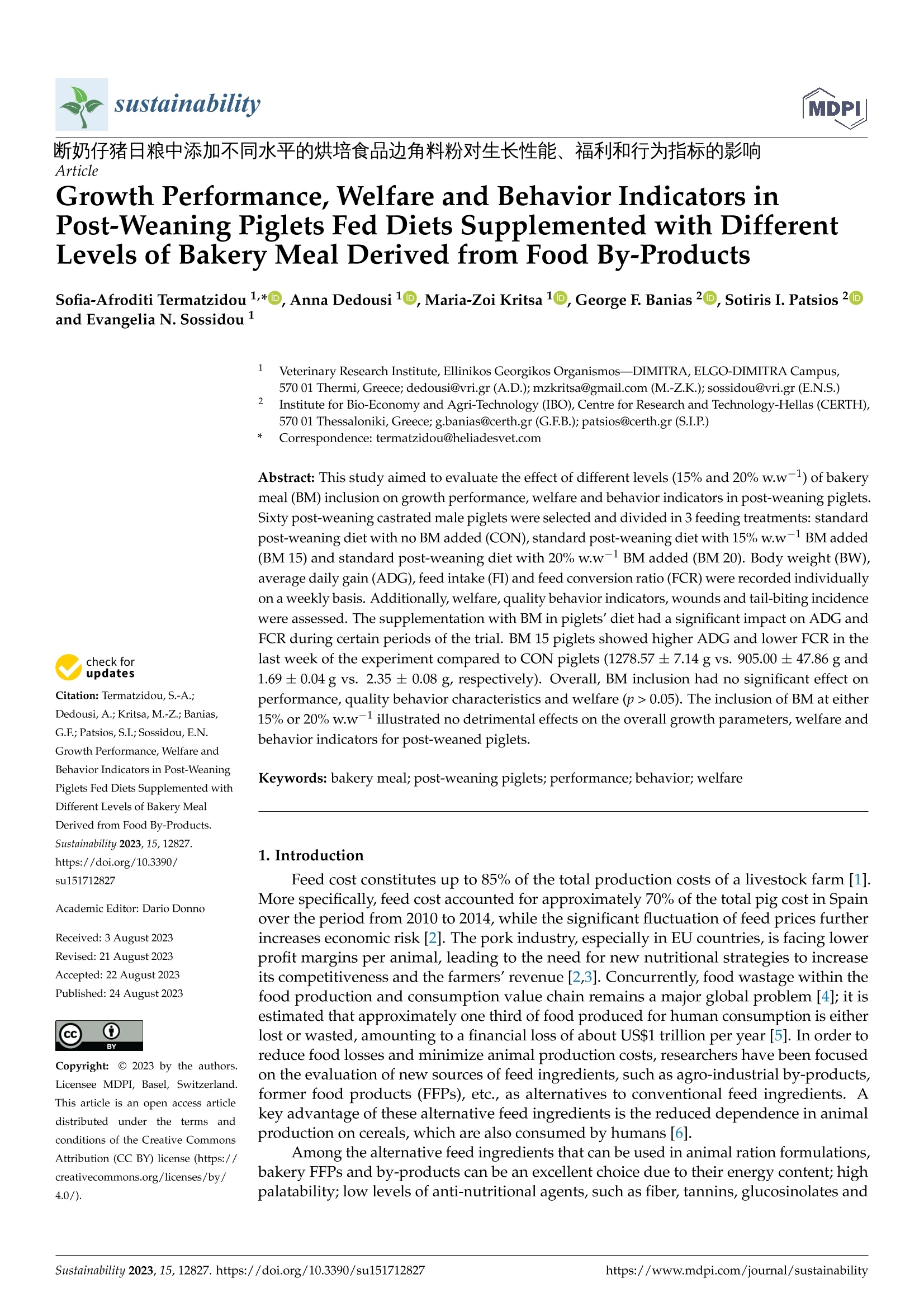
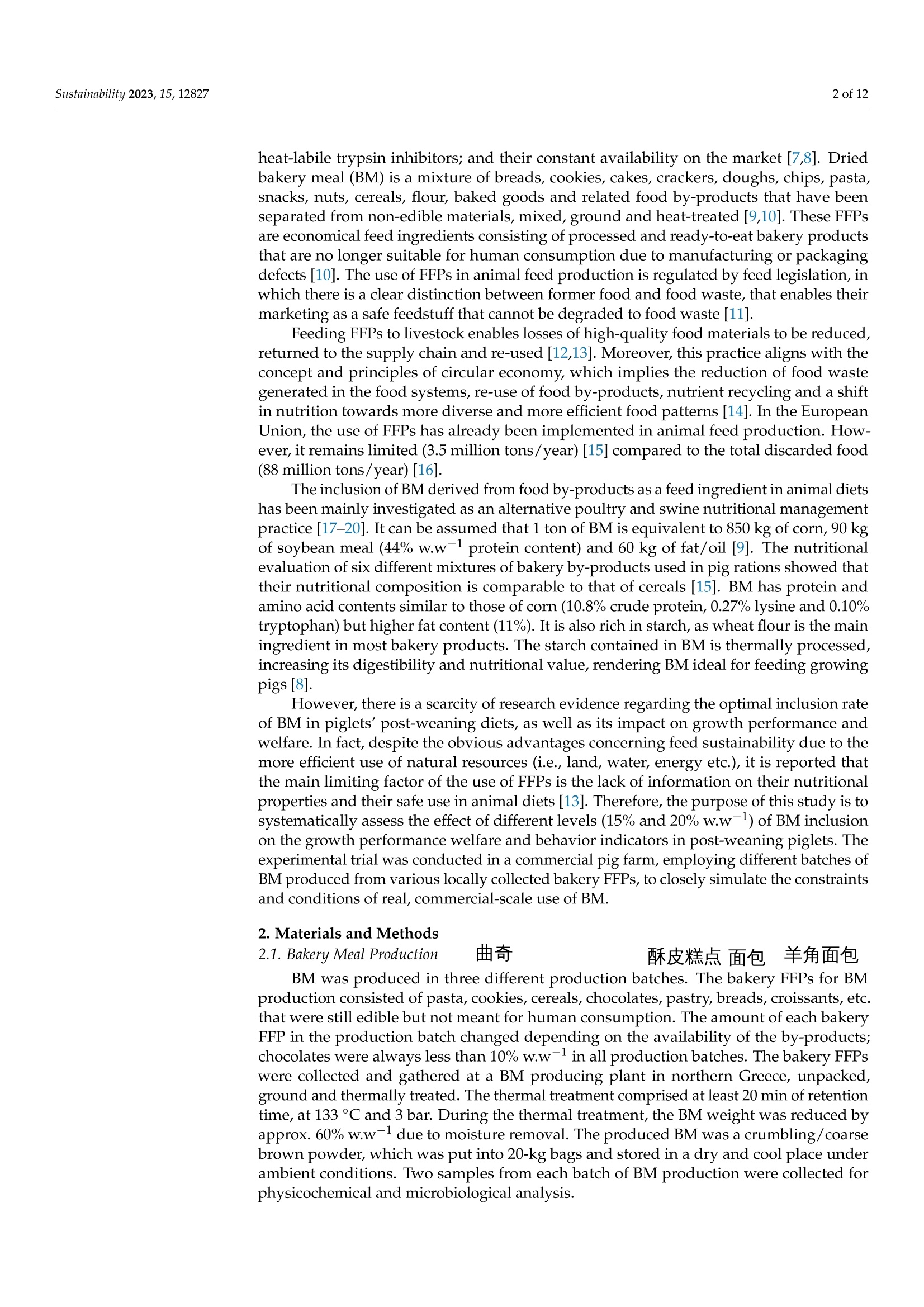

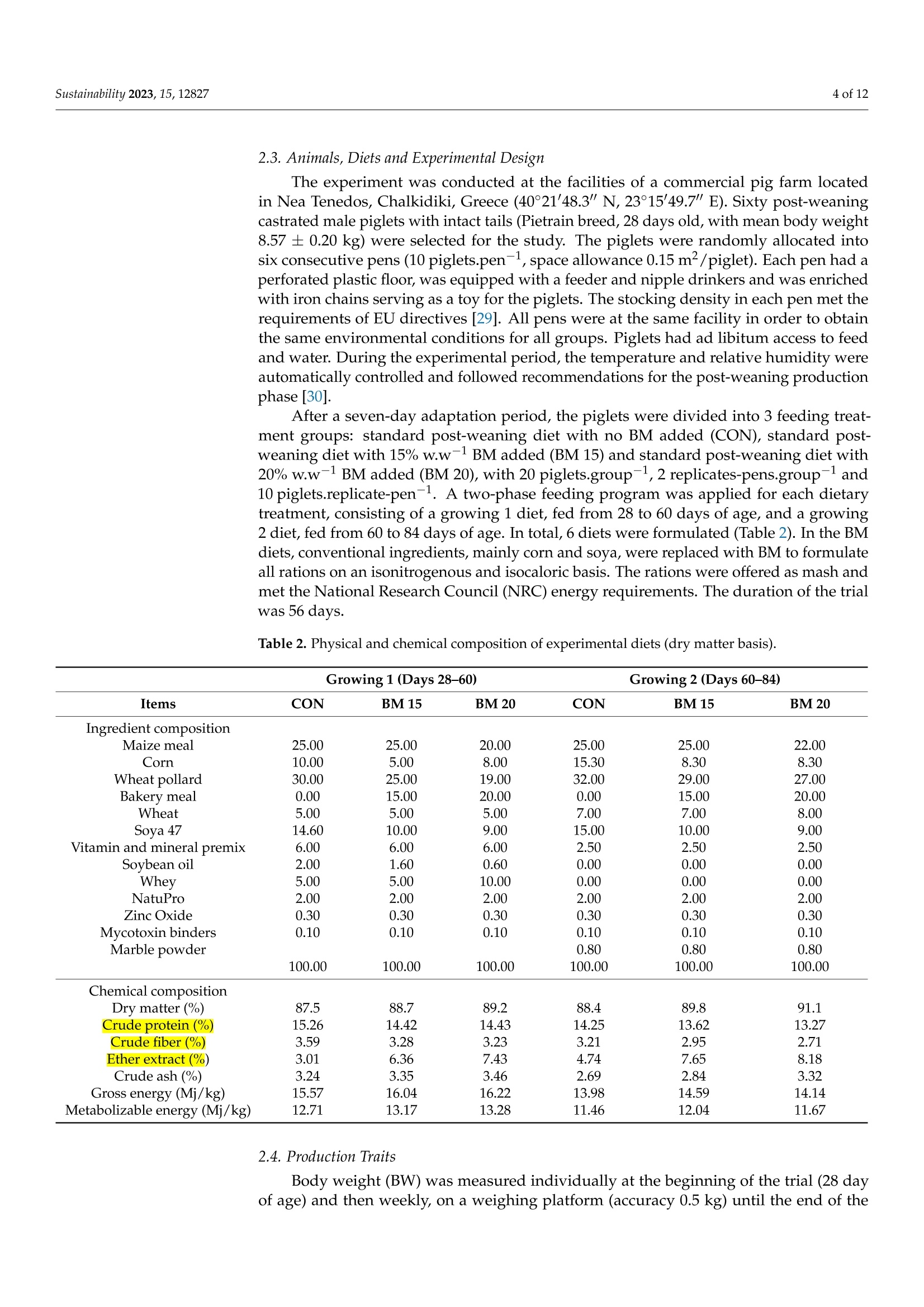




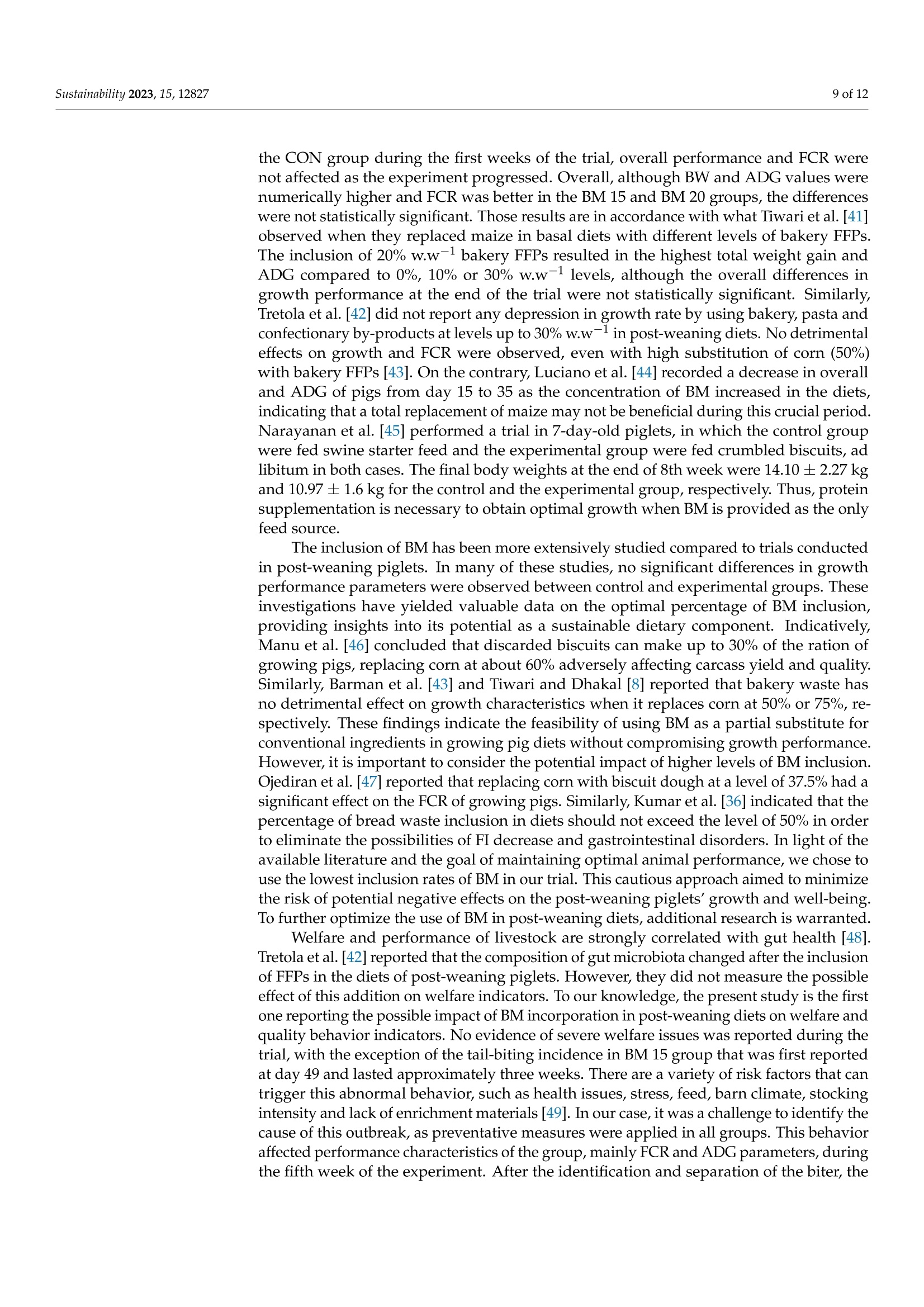
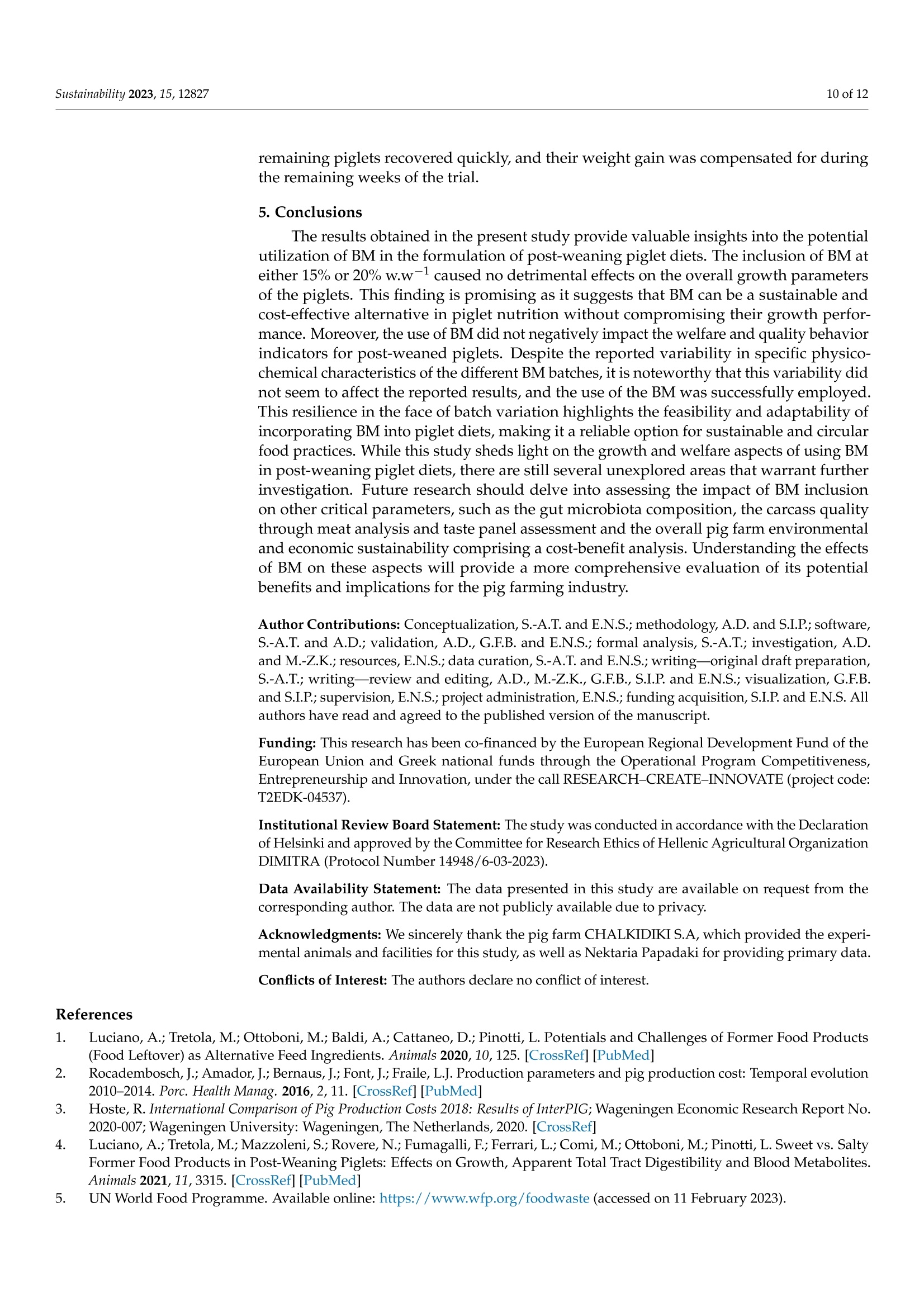


还剩10页未读,是否继续阅读?
中国格哈特为您提供《烘培食品边角料粉脂肪酸含量检测的样品提取和水解前处理》,该方案主要用于饲料中营养成分检测,参考标准--,《烘培食品边角料粉脂肪酸含量检测的样品提取和水解前处理》用到的仪器有格哈特全自动超级水解脂肪测定系统HT6、格哈特快速干燥仪STL56、格哈特全自动快速索氏提取SOXTHERM、格哈特杜马斯定氮仪DT N Pro、格哈特带自动进样器凯氏定氮仪VAP500C、格哈特全自动型纤维分析仪FT12、德国移液器MM
相关方案
更多
该厂商其他方案
更多


